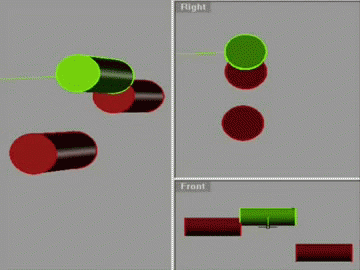RSG Dwell Angle
At one time I found my 0.25 inch Tungsten electrodes were overheating badly, with rapid ablation of the fixed electrodes. This meant constant re-gapping was needed: often even after just 5 mins of run-time.
I was very fortunate in kindly being given some 0.375 inch Copper / Tungsten rod imported from America. I found it is very easily machined, and the alloy has good thermal and conductive properties, so I thought, it would be fairly resistant to ablation as well. Obviously the fact it is a larger diameter than my previous pure Tungsten ones would help matters as well.
At the same time I took the opportunity to also increase the heat sinking of the electrode holders as well. This was achieved by using solid one inch diameter copper rod for the holders, replacing the 0.675" Cu rod I had been using (since replaced with 1.5 inch diameter). I realised however that the dwell angle would then be increased because of the electrode's larger diameters, and this then made me consider the whole the matter of dwell on a RSG, and how it affects things.
Dwell Angle:
What is the dwell angle some people ask? And how critical is it?
On a RSG (Rotary Spark Gap), be it an ARSG or a SRSG type, the dwell angle is the period that one electrode is actually passing over another. So technically it starts the moment the edge of one electrode passes 'over' the other, and finishes when no part of any one electrode is over another.

The fixed electrodes are shown offset
to enhance the effect.
By the time they have physically aligned the tank circuit has most likely discharged fully anyway, as that takes place in millionths of a second.
A better description of the dwell for a RSG therefore would be the period when the electrodes are able to conduct, rather than when they physically align.
The 'angle' part of the name refers to the number of degrees the rotor has rotated during the above operation. The actual angle though is not the important part on a tesla coil, it's the time taken for the whole sequence that matters. So if the rotor revolves at 3000 rpm, that means it makes 50 revs / sec so it takes (1000/50) 20mS to do one revolution.
Then if during the period when the electrodes are able to conduct the rotor travels 2.5 degrees, then the dwell period will be (2.5/360 * 20mS) = 138uS (remember the cap discharges in uSecs - but crucially , it normally takes mSecs to charge up fully).
How important is all this? Well too long a dwell could (I emphasise the word 'could') mean that the electrodes are still in a position to conduct when the capacitor starts re-charging again, leading to the electrodes parting whilst current is flowing. In extreme cases this can cause power arcing (aka the 'ring of fire' effect).
Generally if the capacitor size is realistic for the power then it won't trouble you, but running a 100 bps coil using just 20nF on a 1500 rpm motor, all charged by a pig (an extreme example), means you would have troubles!
So if your coil suffers from this destructive behaviour then it could be a possible reason for it.
As for what is the best dwell period in mS............I would not like to guess.
So much depends on motor speed, disc diameter, bps rate, charging current, capacitor size etc, with things like resonant rise playing a part as well.
I had it occur once with a 1500 rpm SRSG and since then I have always used as big a diameter disc as possible, and a 3000rpm motor.
I had mentioned earlier about the suggestion that the ablation rate of 0.375 inch Copper / Tungsten rod would be slower than pure Tungsten. We sadly it actually ablates the same - if not a bit quicker.
In its favour though is the fact that cutting and machining replacements is much, much easier.
